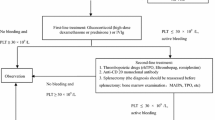Abstract
Despite immune thrombocytopenia (ITP) being one of the most common conditions encountered by the pediatric hematologist, relatively few prospective investigations of ITP exist, and treatment approaches remain highly variable. The ideal prospective clinical trial would use a reduction in severe bleeding as an outcome; however, recent data shows that due to the rarity of severe bleeding events such a trial is not feasible due to the large number of children needed to be enrolled on such studies. Therefore, platelet count is often used a surrogate risk for bleeding severity and an increase in platelet count as the primary outcome in clinical trials. Reliance solely on the platelet count fails to account for relevant patient-related outcomes, among them bleeding severity. Bleeding assessment instruments published to date lack validity and reliability. Therefore, rigorous methods to design and analysis of patient-related outcome measurement tools need to be applied. Once designed appropriately, these measures can be applied to enhance research and help to guide treatment for those patients who truly need it.
Similar content being viewed by others
References
Lilleyman JS (1999) Management of childhood idiopathic thrombocytopenic purpura. Br J Haematol 105:871–875
George JN, Woolf SH, Raskob GE, Wasser JS, Aledort LM, Ballem PJ, Blanchette VS, Bussel JB, Cines DB, Kelton JG, Lichtin AE, McMillan R, Okerbloom JA, Regan DH, Warrier I (1996) Idiopathic thrombocytopenic purpura: a practice guideline developed by explicit methods for the American Society of Hematology. Blood 88:3–40
Eden OB, Lilleyman JS (1992) Guidelines for management of idiopathic thrombocytopenic purpura. The British Paediatric Haematology Group. Arch Dis Child 67:1056–1058
De Mattia D, Del Principe D, Del Vecchio GC, Jankovic M, Arrighini A, Giordano P, Menichelli A, Mori P, Zecca M, Pession A (2000) Acute childhood idiopathic thrombocytopenic purpura: AIEOP consensus guidelines for diagnosis and treatment. Associazione Italiana di Ematologia e Oncologia Pediatrica. Haematologica 85:420–424
Neunert CE, Buchanan GR, Imbach P, Bolton-Maggs PH, Bennett CM, Neufeld EJ, Vesely SK, Adix L, Blanchette VS, Kuhne T (2008) Severe hemorrhage in children with newly diagnosed immune thrombocytopenic purpura. Blood 112:4003–4008
Gaines AR (2005) Disseminated intravascular coagulation associated with acute hemoglobinemia or hemoglobinuria following Rh(0)(D) immune globulin intravenous administration for immune thrombocytopenic purpura. Blood 106:1532–1537
Buchanan GR, Adix L, Klaassen R, Neufeld E, Zimmerman S, Stine K (2004) Quantitative assessment of drug treatment side effects in children with idiopathic thrombocytopenic purpura (ITP). Blood 104:3030
O'Brien SH, Ritchey AK, Smith KJ (2007) A cost-utility analysis of treatment for acute childhood idiopathic thrombocytopenic purpura (ITP). Pediatr Blood Cancer 48:173–180
Klaassen RJ, Blanchette VS, Barnard D, Wakefield CD, Curtis C, Bradley CS, Neufeld EJ, Buchanan GR, Silva MP, Chan AK,Young NL (2007) Validity, reliability, and responsiveness of a new measure of health-related quality of life in children with immune thrombocytopenic purpura: the Kids’ ITP Tools. J Pediatr 150:510–515, 515 e511
Rodeghiero F, Stasi R, Gernsheimer T, Michel M, Provan D, Arnold DM, Bussel JB, Cines DB, Chong BH, Cooper N, Godeau B, Lechner K, Mazzucconi MG, McMillan R, Sanz MA, Imbach P, Blanchette V, Kuhne T, Ruggeri M, George JN (2009) Standardization of terminology, definitions and outcome criteria in immune thrombocytopenic purpura of adults and children: report from an international working group. Blood 113:2386–2393
Buchanan GR, Adix L (2002) Grading of hemorrhage in children with idiopathic thrombocytopenic purpura. J Pediatr 141:683–688
Bolton-Maggs PH, Moon I (1997) Assessment of UK practice for management of acute childhood idiopathic thrombocytopenic purpura against published guidelines. Lancet 350:620–623
Page LK, Psaila B, Provan D, Michael Hamilton J, Jenkins JM, Elish AS, Lesser ML, Bussel JB (2007) The immune thrombocytopenic purpura (ITP) bleeding score: assessment of bleeding in patients with ITP. Br J Haematol 138:245–248
Bennett CM, Rogers ZR, Kinnamon DD, Bussel JB, Mahoney DH, Abshire TC, Sawaf H, Moore TB, Loh ML, Glader BE, McCarthy MC, Mueller BU, Olson TA, Lorenzana AN, Mentzer WC, Buchanan GR, Feldman HA, Neufeld EJ (2006) Prospective phase 1/2 study of rituximab in childhood and adolescent chronic immune thrombocytopenic purpura. Blood 107:2639–2642
Meyer KB, Clayton KA (2009) Measurement and analysis of patient-reported outcomes. Methods Mol Biol 473:155–169
Gregory DM, Way CY (2009) Qualitative research in clinical epidemiology. Methods Mol Biol 473:203–215
Barnard D, Woloski M, Feeny D, McCusker P, Wu J, David M, Bussel J, Lusher J, Wakefield C, Henriques S, Blanchette V (2003) Development of disease-specific health-related quality-of-life instruments for children with immune thrombocytopenic purpura and their parents. J Pediatr Hematol Oncol 25:56–62
von Mackensen S, Nilsson C, Jankovic M, Mirra N, D'Angelo E, Borkhardt A, Ljung R (2006) Development of a disease-specific quality of life questionnaire for children and adolescents with idiopathic thrombocytopenic purpura (ITP-QoL). Pediatr Blood Cancer 47:688–691
Mathias SD, Bussel JB, George JN, McMillan R, Okano GJ, Nichol JL (2007) A disease-specific measure of health-related quality of life for use in adults with immune thrombocytopenic purpura: its development and validation. Health Qual Life Outcomes 5:11
Mathias SD, Gao SK, Miller KL, Cella D, Snyder C, Turner R, Wu A, Bussel JB, George JN, McMillan R, Wysocki DK, Nichol JL (2008) Impact of chronic immune thrombocytopenic purpura (ITP) on health-related quality of life: a conceptual model starting with the patient perspective. Health Qual Life Outcomes 6:13
Mathias SD, Gao SK, Rutstein M, Snyder CF, Wu AW, Cella D (2009) Evaluating clinically meaningful change on the ITP-PAQ: preliminary estimates of minimal important differences. Curr Med Res Opin 25:375–383
Author information
Authors and Affiliations
Corresponding author
Rights and permissions
About this article
Cite this article
Neunert, C.E. Evaluating bleeding severity in immune thrombocytopenia (ITP). Ann Hematol 89 (Suppl 1), 47–50 (2010). https://doi.org/10.1007/s00277-010-0930-4
Received:
Accepted:
Published:
Issue Date:
DOI: https://doi.org/10.1007/s00277-010-0930-4




